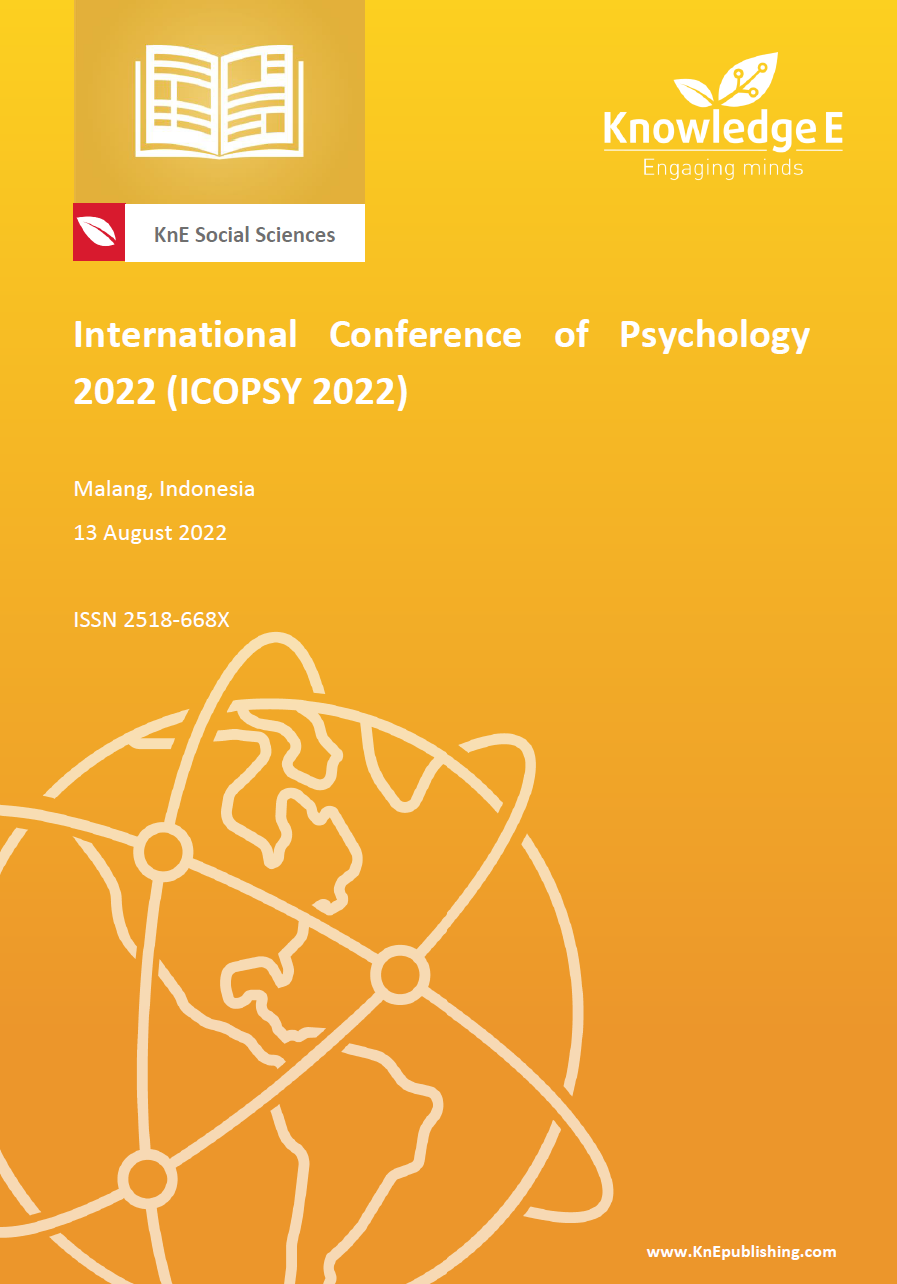Relationship Between Organizational Commitment and Employee Satisfaction of PT X
DOI:
https://doi.org/10.18502/kss.v7i18.12390Abstract
This research aims to examine the relationship between job satisfaction and organizational commitment in employees of PT X. This study used quantitative research with a correlational research design. The research population were all the employees of PT X, 34 employees in total The sampling technique used is saturated sampling. The data collection method used is the adaptation of the Organizational Commitment Scale (OCS) and the generic job satisfaction scale with the validity used in this study is a validity construct. The data analysis technique used in this research is product-moment correlation. The results of the hypothesis test show that the organizational commitment of most of the employees of PT X is in very high classification, the job satisfaction of most of the employees of PT X is included in the high classification, and the positive relationship of employees of PT X between organizational commitment and job satisfaction. The author hopes that further researchers will make this research a valid reference for future research. And the authors suggest to develop this research.
Keywords: organizational commitment, employee, statisfaction
References
[2] Ramseook-Munhurrun P, Naidoo P, Bhiwajee SL. Measuring service quality: Perceptions of employees. Journal of Business Research. 2010;4(1):47-58.
[3] Suwatno H, Priansa DJ. Manajemen SDM dalam organisasi publik dan bisnis. Bandung: Alfabeta; 2011.
[4] Hammer TH, Avgar Ac. The impact of unions on job satisfaction, organizational commitment and turnover. Journal of Labour Research. 2005;26(2):241-266. https://doi.org/10.1007/s12122-005-1024-2
[5] Bashayreh AMK. Organisational culture and job satisfaction: A case of Academic staffs at Universiti Utara Malaysia (UUM). Thesis, University Utara Malaysia; 2009. https://etd.uum.edu.my/1632/2/1.Anas_Mahmoud_Khaled_Bashayreh.pdf
[6] Robbins SP. Perilaku organisasi. 16th. ed. Jakarta: Salemba Empat; 2015.
[7] Yuwono I, Suhariadi F, Handoyo S, Fajrianti, Muhamad BS, Septarini BS. Psikologi Industri dan Organisasi. Surabaya: Fakultas Psikologi Universitas Airlangga; 2005.
[8] Robbins SP, Judge TA. Organizational behavior. 12th ed. Upper Saddle River, NJ: Pearson Prentice Hall; 2007.
[9] Tania A, Sutanto ED. Pengaruh motivasi kerja dan kepuasan kerja terhadap komitmen organisasional karyawan PT. DAI KNIFE di Surabaya. Agora. 2013;1(3), 1-9.
[10] Meyer JP, Stanley DJ, Herscovitch L, Topolnytsky L. Affective, continuance and normative commitment to the organization: A meta analysis of antecedents, correlates and consequences. Journal of Vocational Behavior. 2002;61(1):20–52. https://doi.org/10.1006/jvbe.2001.1842
[11] Mathis RL, Jackson HJ. Human resource management. 10th ed. Jakarta: Salemba Empat; 2011.
[12] Dolontelide CM, Latjandu LD. Ipteks peningkatan kinerja karyawan Pada PT. Bursa Efek Indonesia Kantor Perwakilan Sulawesi Utara. Jurnal Ipteks Akuntansi Bagi Masyarakat. 2018;2(2):279–283. https://doi.org/10.32400/jiam.2.02.2018.21744
[13] Wicaksono BA, Masykur AM. Hubungan Antara komitmen organisasi dengan organizational citizenship behavior pada karyawan PT X. Jurnal Empati. 2018;7(3):967-973. https://doi.org/10.14710/empati.2018.21842
[14] Muayyad DM. Pengaruh kepuasan kerja terhadap produktivitas kerja pegawai Bank Syariah X Kantor Wilayah II. Jurnal Manajemen Dan Pemasaran Jasa. 2017;9(1):79– 102.
[15] Cahyani RA, Sundari O, Dongoran J. Pengaruh komitmen organisasi dan kepuasan kerja terhadap kinerja karyawan (Studi pada Perusahaan Daerah Air Minum (PDAM) Kota Salatiga. Jurnal Ekonomika Dan Bisnis Dewantara. 2020;3(1):1–10. https://doi.org/10.26460/ed_en.v3i1.1288
[16] Kreitner R, Kinicki A. Organizational behavior. New York: McGraw-Hill education; 2011.
[17] Meyer JP, Allen NJ. Commitment in the workplace: Theory, research and application. London: Sage Publications, Inc; 1997.
[18] Greenberg J, Baron RA. Behavior in organizations. 9th. ed. New Jersey: Pearson Education; 2008.
[19] Allen NJ, Meyer JP. The measurement and antecedents of affective, continuance, and normative commitment to organization. Journal of Occupational Psychology. 1990;63:1–18.
[20] Indermun MV, SaheedBayat M. The job satisfaction-employee performance relationship: A theoretical perspective. International Journal of Innovative Research in Management. 2013;2(11):1-9.
[21] Artimany NS, Gelogir LD. Job satisfaction among employees in small scale industries, Visakhapatnam. Journal of Business Management & Social Sciences Research. 2013;2(10):20-26.
[22] Robbins SP. Perilaku organisasi: Konsep, kontroversi, aplikasi. 8th. ed. Jakarta: Prenhallindo; 2001.
[23] Devi NMBS, Noer BA, Rahmawati Y. Analisis perbandingan pegawai tetap dan pegawai outsourcing ditinjau dari pemberdayaan, kepuasan kerja, dan komitmen organisasional. Jurnal Sains & Seni ITS. 2017;6(2), 276-280. https://doi.org/10.12962/j23373520.v6i2.26119
[24] Luthans F. Organizational behavior an evidence-based approach. New York: McGraw- Hill; 2005.
[25] Beardwell J, Holden L, Claydon T. Human resource management: A contemporary approch. London: Prentice Hall; 2010.
[26] Stum DL. Five ingredients for an employee retention formula. (Special report on recruitment & retention). Journal of Human Resources Focus. 1998;75(9), 9-11.
[27] Trisnaningsih S. Motivasi sebagai moderating variable dalam hubungan antara komitmen dengan kepuasan kerja (Studi empiris pada akuntan pendidik di Surabaya). Jurnal Manajemen, Akuntansi & Sistem Informasi. 2004;4:101-113.
[28] Mathieu JE. A cross-level non recursive model of antecedents of organizational commitment and job satisfaction. Journal of Applied Psychology. 1991;76(5):607- 618. https://doi.org/10.1037//0021-9010.76.5.607
[29] Sugiyono S. Statistika untuk penelitian. Bandung: Penerbit Alfabeta; 2014.
[30] Macdonald S, MacIntyre P. The generic job satisfaction scale: Scale development and its correlates. Employee Assistance Quarterly. 1997;13(2):1-16. https://doi.org/10.1300/J022v13n02_01v
[31] Wagner JA, Hollenback JR. Organizational behavior: Securing competitive advantage. Routledge; 2010.
[32] Azim S, Gale AW, Lawlor-Wright T, Kirkham R. The importance of soft skills in complex projects. International Journal of Managing Projects in Business. 2010;3(3):387-401. https://doi.org/10.1108/17538371011056048
[33] Wibowo Perilaku dalam organisasi. Jakarta: Rajawali Pers; 2016.
[34] Boles J, Madupalli R, Rutherford B, Wood JA. The relationship of facets of salesperson job satisfaction with affective organizational commitment. Journal of Business and Industrial Marketing. 2007;22(5):311-321.
[35] Oyewobi LO, Suleiman B, Muhammad-Jamil A. Job satisfaction and job commitment: A study of quantity surveyors in Nigerian Public Service. Journal of Business and Management. 2012;7(5):179-192. http://dx.doi.org/10.5539/ijbm.v7n5p179
[36] Schmit MJ, Allscheid SP. Employee attitudes and customer satisfaction: Making theoretical and empirical connections. Personnel Psychology. 2006;48(3):521-536. https://doi.org/10.1111/j.1744-6570.1995.tb01768.x
[37] Testa MR. Organizational commitment, job satisfaction, and effort in the service environment. The Journal of Psychology Interdisciplinary and Applied. 2001;135(2):226- 236. https://doi.org/10.1080/00223980109603693

